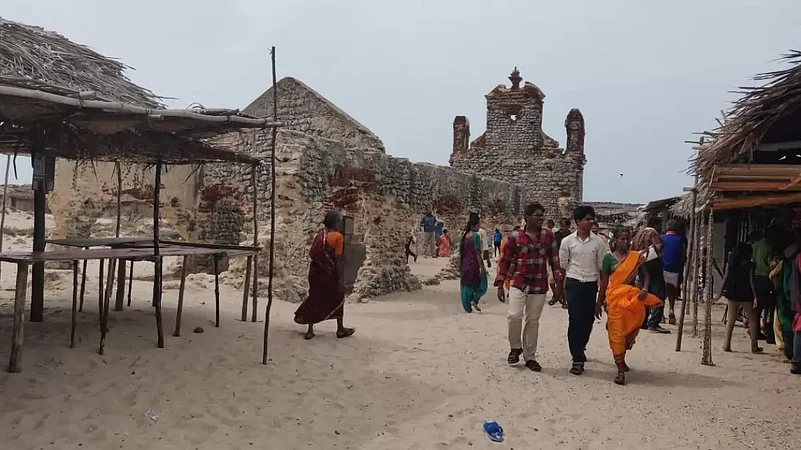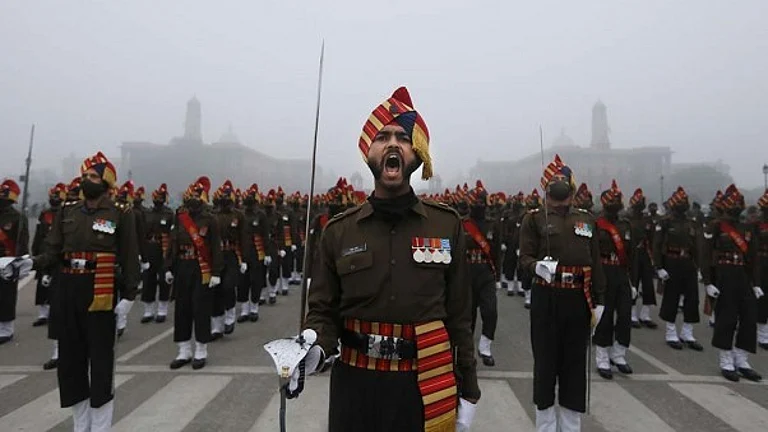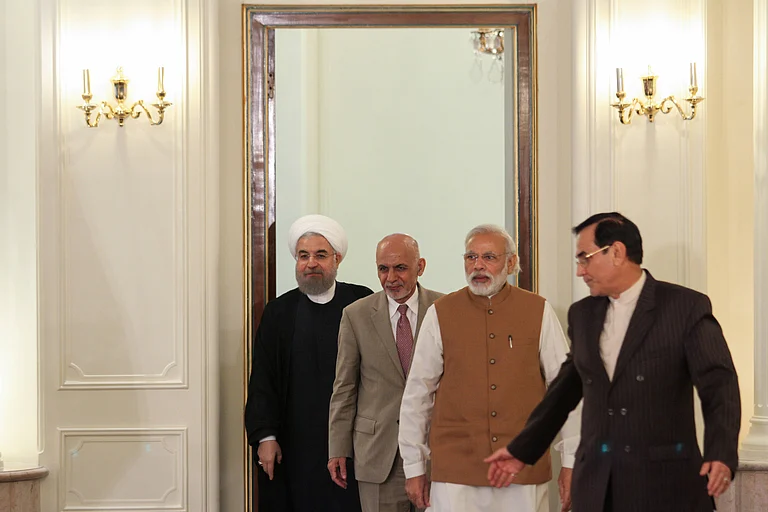At the furthermost tip of the abandoned little town of ‘Dhanushkodi’ on the Pamban Island of Tamil Nadu, a stretch of shallow sand called ‘Land End’ is popular with overseas tourists. When the tide is manageable, local tour guides take truckloads of visitors across the silvery slice of the beach to the tip of the city and point across the ocean.
“You can see Sri Lanka from here,” they assert as tourists squint their eyes to get a glimpse.
There is a belief that this was the spot from which Rama crossed over to Sri Lanka to fight Ravana in the Ramayana, which at present is about 24 km away from the coastal town. The nearby municipality and temple town of Rameshwaram is a popular Hindu temple destination.
But Dhanushkodi is a ghost town.
On the night of December 22, 1964, the great Rameshwaram cyclone made landfall in the little village, with winds blowing at the speed of 280 km per hour and tidal waves 23 ft high. At least 1,800 people, including 115 people travelling on the Pamban-Dhanushkodi train, died in the storm. The marooned town was soon declared ‘unfit for living’ by the Government of Madras.
In 2004, the water level around Dhanushkodi receded, revealing for a brief spell the submerged portions of the town before the deadly tsunami struck Tamil Nadu and nearby regions.
In 2013, R. Sunderaraj, the station master of Dhanuhkodi on its fateful night and the Indian Railways’ last living link to the tragedy, passed away at his home in Madurai. With him died the last known first-hand account of the cyclone that had wiped out a city overnight. In a 2013 article, Sunderaraj’s wife Gladys had recalled how they along with their three little children had waded out into the water which flooded their coastal home on that night and were stranded on the railway station for over a week before they were rescued by a ship. They were one of the few survivors of the tragedy.
But the cyclone lives on in the collective living memory of the people who today live around Dhanushkodi, the town that was never deemed fit to live. These people include fishermen and their families, coconut water sellers, auto drivers and small shopkeepers selling tea, Maggie, and snacks to the inveterate tourists who arrive in droves on weekends and holidays to spend time with the ghosts of the erstwhile town. The settlements are temporary, the shopkeepers come and go.
Remnants of the old town include the ‘Old Railway Station’ built by the British that was destroyed in the cyclone in 1964. Bits of the passenger train with the 115 people had also surfaced in 2004. Near the beach, one tall church wall stands erect along with parts of a temple. The locals believe that God of the world himself saved the church and the temple from destruction, though its protection did not extend to the mortals.
Dhanushkodi represents, in anthropologist Jonathan Skinner’s words, “a stark contrast between absence and presence, the imagined past and the experienced present”. Skinner wrote about revisiting the ‘ghost town’ of Montserrat, a British colony in the Caribbean from where he was evacuated due to a volcanic eruption in 1995.
“We are eternally displaced —or deferred, in a Derridean sense— as we make friends on our journeys abroad and remain strangers to those back home, living both in and out of our places,” he wrote in his paper Ghosts in the Head and Ghost Towns in the Field: Ethnography and the Experience of Presence and Absence.
A ghost town is a contradiction, a living memory. It’s often a site to behold. In India, another ghost town remains popular with travellers and thrill seekers — the haunted Bhangarh Fort in Rajasthan which was abandoned centuries ago and is now said to reek with the ghosts of the hapless priests and rulers who brought ruin on the town. Built in the 17th century by Raja Madho Singh, the fort that included around 9,000 residential homes was slowly abandoned around 1720 and onwards. Many theories abound to why the town was abandoned. A particularly favourite story among the locals revolves around a priest who fell in love with the princess and cursed the town when he was rejected, bringing ruin on the villagers and the royalty. It is believed that the curse of the priest brought forth an earthquake that led to the sudden desertion of the prosperous town.
There is something ominous about the tale and the roofless walls of the abandoned homes spread out in the shadow of the broken fort that speak of a violent transition. The reason for abandoning Bhangarh remains a secret that the residents took to their graves. But the curse lives on in the cautionary tales and visitors are prohibited to enter the fort after sunset. Even the guard at the gate locks up and leaves, stating that it gets creepy at night. If the ghosts of Bhangarh do indeed come back to reclaim the ghost town in the night, locals believe they deserve privacy. Much like the walls of the present remains, the walls that are absent continue to complete the collective memory of the people in the nearby villages who keep the old glamour of the court of Bhangarh and its residents alive in their tales.
Living parallel with ‘Ghost towns’ are ‘Lost towns’, which are yet to be fully rediscovered but are nevertheless found in the living memory and post memory of people. The port town of Muziris dating back to the 13th century is believed to have been an important hub for commerce and international spice trading in Malabar at the time. Though the exact location of the city is not known, experts believe it was located somewhere on the banks of the river Periyar near Pattanam, an archaeological site north of Cochin in Kerala. It is believed that the city was destroyed in the 1341 floods in the region when the Periyar swelled and swallowed the city. In 2018 when Kerala saw its worst flood in over a hundred years, remains of what is believed to be Muziris were also at risk of being washed away.
The recent earthquake in Turkey-Syria has left three historical cities critically damaged and on the brink of collapse: Antakya, Sanliurfa, and Aleppo have been reduced to dust and rubble by a series of powerful earthquakes that left over 40,000 dead, turning entire cities into graveyards. But it isn’t just life that was lost.
In Salinfura, megalithic structures put up by humans predate the pyramids by 7,000 years, making them some of the oldest pieces of architecture in the world. The 4,000-year-old Aleppo is one of the oldest cities in the world to have been constantly inhabited.
Once the dust of the rescue machines and debris settles, will these towns also become ‘ghost towns’? Lamenting the loss of Antakya that was home to an ancient Jewish community in Turkey, President of the Turkish Jewish community Ishak Ibrahimzade called the earthquake “the end of a 2,500-year-old love story”. Formed in 300 BCE by a general associated with the army of Alexander the Great, Antakya has changed many hands and regimes and has seen the tides of history and civilization turn.
Much of its stories lie buried in rubble today along with a cultural legacy that may be lost forever.
It is true that cities can be rebuilt. Memories can be reconstructed. And cracks can be mended. But death cannot be undone. Can a dead city be truly reconstructed if its residents remain unalive?
We are what Marianne Hirsch calls "the generation of post-memory". Exposed to traumatic experiences of years that preceded our birth, we live the trauma — perhaps experienced by a parent, a friend, a city as our own. These memories are not our own but “nevertheless transmitted to (us) so deeply as to seem to constitute memories in their own right”.
The loss of a city due to an earthquake is a geopolitical phenomenon and means many things to many people — a lapse in city planning, a shift in tectonic activities, a result of illegal fracking, even an ‘act of God’. But it is also the site for the creation of post-memory and ghosts that never abandon the city even if the living do.


























